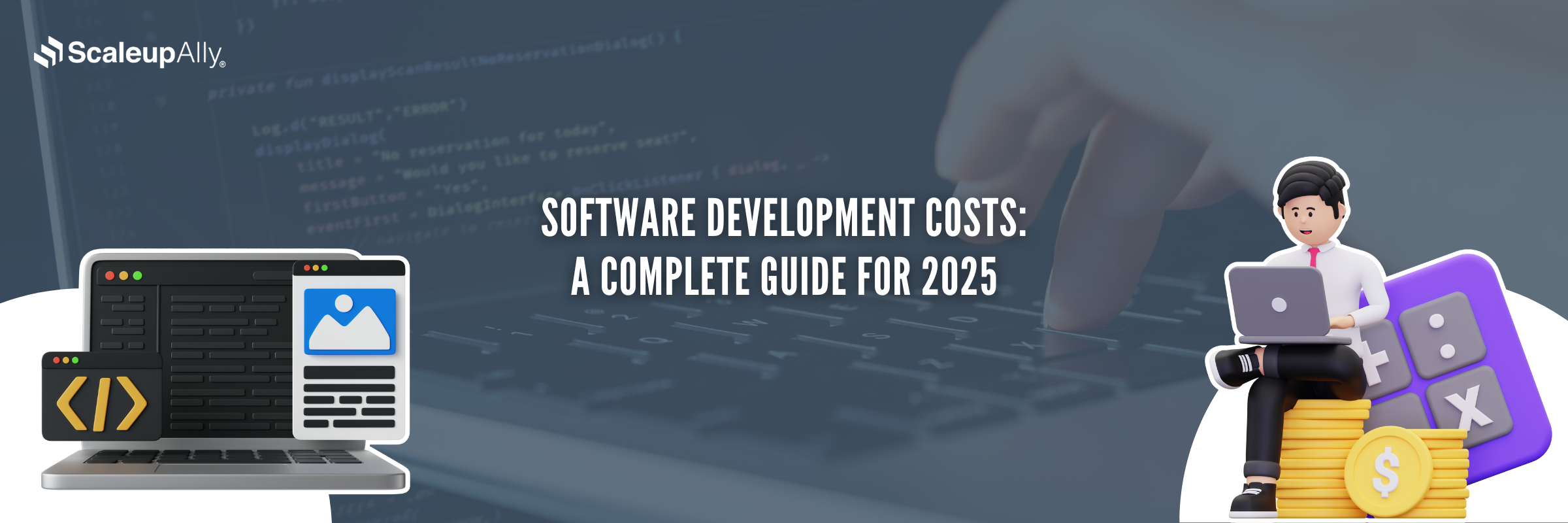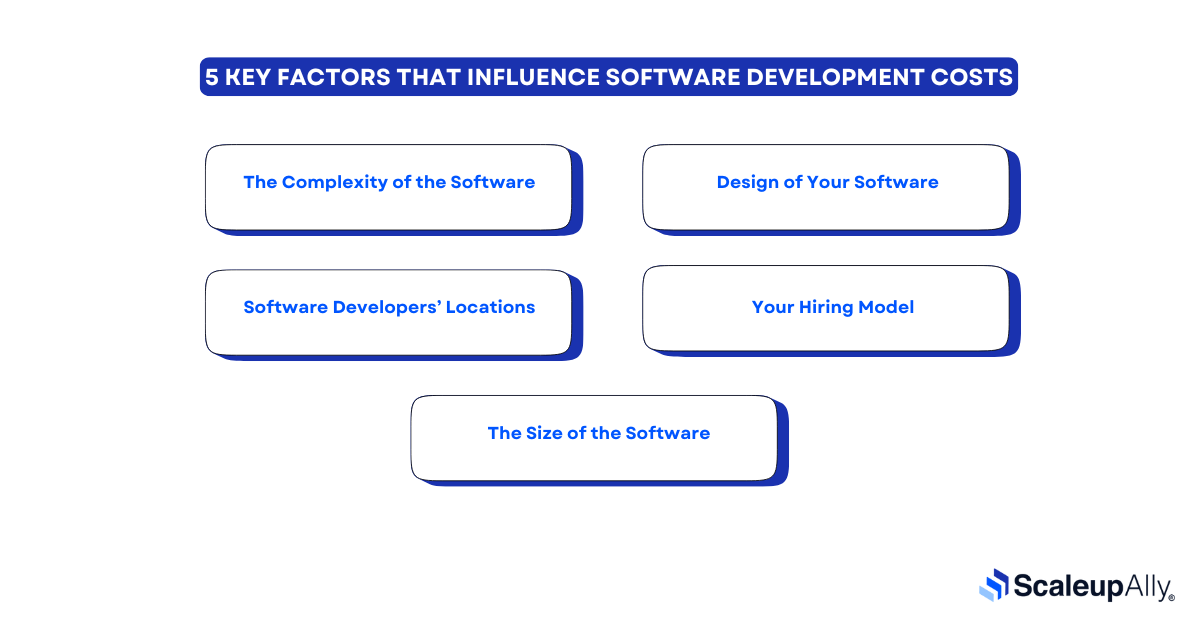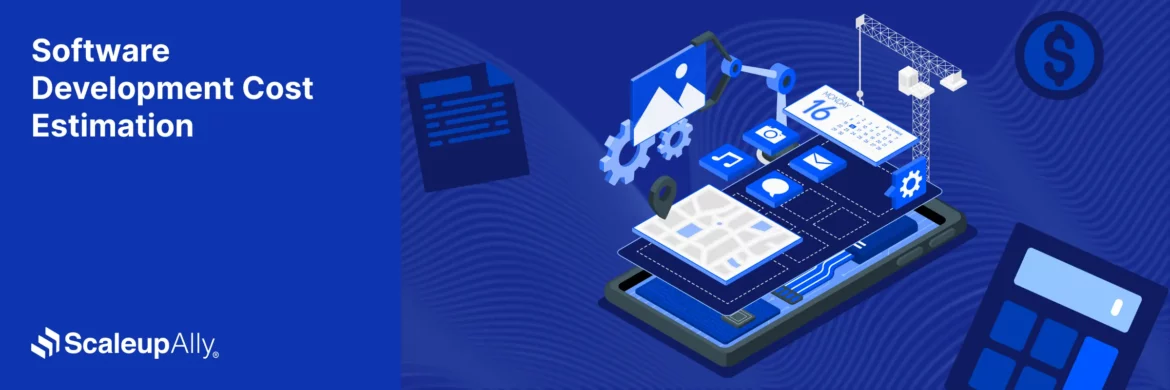
Software Development Costs: A Complete Guide for 2025
Manu Jain | October 27, 2024 , 17 min read
Table Of Content
Up to 45% of software projects exceed budget during deployment, which can cause businesses great anxiety. How can good software be built with the best balance between price and functionality?
You probably ask this question at every software development meeting.
Read on to determine software development costs, the factors that affect their pricing, and how to keep this balance.
Key Takeaways
- Software development costs can range widely from $10,000 to $500,000+, depending on factors like complexity, team size, design, and ongoing maintenance.
- The biggest cost influencers include software complexity, UI/UX design quality, developer location & hiring model (in-house vs outsourcing).
- Accurately estimating costs requires defining the project scope, breaking work into phases, selecting the right team and accounting for long-term needs like updates and testing.
- You can reduce development costs by focusing on MVPs, using agile methodologies, automating testing & outsourcing to cost-effective regions.
- Choosing the right development model—in-house, outsourced or project-based—can greatly impact both short- and long-term costs.
Software Development Costs: The Short Answer
- Software Development Costs: The Short Answer
- 5 Key Factors That Influence Software Development Costs
- Estimating Software Development Costs
- Cost Breakdown by Software Type
- How to Reduce Software Development Costs?
- Common Software Development Models and Their Cost Implications
- Build Cost-Effective Custom Software With ScaleupAlly
- Conclusion
- Frequently Asked Questions
It can range from US$10,000 to US$500,000.
We acknowledge the huge gap in the mentioned figures. This is because cost also depends on the size of the development team and sometimes how long it will take to code.
The cost will be lower for a small application. But if we are talking about fully-fledged software with numerous sophisticated integrations and features, the cost can go higher.
Let’s not forget the maintenance and updates that follow development. All these add up to the cost of software development.
5 Key Factors That Influence Software Development Costs
Just like every other project, some factors constitute pricing and software development is no different. Key factors influencing the cost of software development are asfollows:

1. The Complexity of the Software
Software complexity is defined by its underlying logic and the advanced functionality it offers. When software has intricate logic, it often requires extensive coding to ensure that it operates effectively. This complexity can arise from several factors:
- If the software needs to perform complex tasks like analyzing data or performing high-level computations.
- Some businesses’ operations are unique, and they will need the software to perform in a certain way to align with their strategies.
- Lines of code can be measured by the software’s complexity. Complex software has more lines of code, running into tens of thousands or even over 100,000 lines.
2. Design of Your Software
A good user interface is the trick to getting active users for your software. An irresistible UI/UX design will make it easy to use and visually appealing.
The design incorporates everything from the colors, icons, fonts, buttons, audiovisuals, and navigation to make the software a pleasant and a good experience for your targeted audience.
Aesthetics matter! Invest in a sleek design to elevate your software. If you want custom animations, a responsive layout, or personalized interfaces, the development time and budget will need to expand.
Design can be expensive, but it’s worth the price because it helps build a loyal user base.
3. Software Developers’ Locations
The biggest factor in custom software development costs is paying the software developers, and this cost can vary depending on where you are hiring from. Currently, different countries and even cities have different hourly rates for software developers.
If we look at the USA and Western Europe, they usually charge higher rates because of the higher average income and cost of living.
For such a reason, many business owners, startups, and enterprises hire developers from Asian countries, where rates are often lower. India is a popular example where highly skilled developers are in abundance at pretty economical rates.
4. Your Hiring Model
The decision on how you will work with your developers depends on three main hiring models: in-house, freelancing, and outsourcing.
- In-house Team: With this, you will hire your own full-time developers. You are responsible for seeding applicants, interviewing them, and onboarding them. This model can produce high-quality work, but it has the disadvantage that it takes a lot of time and money to find, train, and support these employees.
- Freelancing: This is the cheapest option. You hire individual developers for specific tasks and when the project is completed, they leave. However, even though this model is cheap, the quality of work may not be as good and freelancers might not be as reliable or motivated.
- Outsourcing: This model combines benefits from both in-house teams and freelancers. It’s less expensive than hiring an in-house team but still gives you access to skilled developers. There are three types of outsourcing arrangements:
- Fixed-rate or Project-based: You hire a team for a specific project with set goals and deadlines.
- Hourly Rate: You can hire developers and pay them based on the hours they work.
- Dedicated Team: You get a specific team of developers working just for you, which ensures better quality and expertise.
5. The Size of the Software
Size here refers to the number of screens the software has. The more screens, the more time it takes to develop, which increases the cost.
Here is how the size of software is categorized:
- Small projects: 10-25 screens, come in handy when you are building an MVP. These types of projects have a limited scope, lower budget, and shorter timelines.
- Mid-size projects: 25-40 screens, have more features, integrations with multiple systems and databases, and other necessary functionality. They require more resources, time, and a larger budget.
- Enterprise Projects: More than 40 screens and collaboration between multiple departments of the organization are required. The software will also need to align with the business’s strategy. This complexity makes it more expensive.
For clarity on the number of screens, every unique view counts as a separate screen, even if the screens display similar information.
A screen to view client details and one to edit those details are considered two different screens.
Also read: How to Calculate ROI for Software Development?
Estimating Software Development Costs
Have you watched someone hit a moving target? That’s how it feels trying to estimate the cost of software development because there are so many variables involved. But we can make an educated guess by breaking down the components of software development into chunks and then assigning realistic financial figures to each part.
Once this is done, we will be able to understand the scope of the work and how long each task will take and then multiply that by the cost of the resources needed to complete it.
1. Define the Scope of Your Project
The first step in getting this right is to define the project’s scope. Defining the scope means deciding what features and functionalities the software will have. How complex will it be? What sort of integrations will you need? Do you need a custom dashboard? The more detailed the scope, the more accurate the costs are likely to be.
2. Break it into Development Phases
Once you’ve nailed down the scope, you can break it into development phases (e.g., design, coding, testing, and deployment). Each of these stages will have its own timeline and cost. The design phase for example, might take a few weeks and cost less while the development phase could take months and be the most expensive part of the project.
3. Choosing your Team
When choosing your team, your hiring model (as covered earlier) and where you hire from can affect software development costs. The rates will vary depending on their expertise and the size of the team. Developers in different regions charge different rates, with North American and European teams generally costing more than those in regions like Asia.
4. Time Needed
If you need your software at an earlier time, you will need to hire more developers to work on the project or request that your developers work extra hours. These changes will require that you expand your budget a little bit more because shorter timelines often mean higher costs.
5. Misc Costs
Don’t forget the other costs (testing, maintenance, and post-launch updates). These are ongoing expenses that should be built into your overall budget because your software will likely need to evolve over time as your users provide feedback and new technologies emerge.
What Your Software Might Cost?
Use our Software Development Cost Calculator to obtain a quick and reliable cost breakdown.

Cost Breakdown by Software Type
We have categorized software into three types in this section to explain the costs associated with software development. The aim is to give you an understanding of the average cost of software development.
1. Small-Sized Software (Cost Range: US$10,000 – US$50,000)
Small-sized software is usually less complex in functionality. They are mostly single-feature software that doesn’t do much technically. So a simple to-do list app or a calculator are examples of small-sized software. Such apps do not require so much time to develop.
A team for such projects will consist of a few developers, a designer, and a tester to build and ship in a few weeks to a few months. This type of software is mostly suitable for small businesses or startups with a limited budget.
2. Medium-Sized Software (Cost Range: $50,000 – $150,000)
Still not as complex as enterprise-scale software, yet, they contain complex functionalities and many features. Project management software and a customer relationship are examples of medium-sized software.
You will need a few more developers for such a project compared to small-sized software, including front-end and back-end developers, UI designers, and testers.
3. Large/Enterprise-Sized Software (Cost Range: $150,000 – $500,000+)
These are complex projects with multiple integrations, heavy data processing, and often scalability to support thousands or millions of users. Think along the lines of:
- A comprehensive ERP system.
- A custom CRM platform with data analytics, automation, and integrations with other business tools.
- A multi-platform SaaS product with mobile, web, and desktop apps that all sync together.
This is where things get expensive. It can take many months or even years, depending on the project to fully code it. You’ll need a large team with specialized roles. They may include developers, architects, project managers and designers.
Enterprise-sized software is typically undertaken by established businesses or organizations that require a highly reliable, scalable solution.
How to Reduce Software Development Costs?
It is possible to reduce software development costs without compromising quality when you plan strategically and adopt efficient practices. Here are some key strategies you can follow in order to bring down the development costs:
1. Outsource Development Tasks
To significantly cut expenses, outsource software development to regions with lower labor costs such as Eastern Europe or South Asia. However, when making the decision, select reliable partners who adhere to strict quality standards to avoid costly revisions later in the process.
2. Clarify Requirements from the Start
It is common for ambiguous project requirements to lead to scope creep and increased development time. To avoid this, document the software’s features and goals right from the beginning, along with regular updates. This ensures that the developers stay on track and also minimizes misunderstandings and extra costs.
3. Use Agile Development Methodologies
The Agile approach allows you to iterative the development process and encourages feedback continously from stakeholders. This will be able to reduce rework and accelerate time-to-market by identifying issues early in the development process. The outcome of this would be better cost control.
4. Focus on Minimum Viable Product (MVP)
Building an MVP with essential features helps launch faster and at a lower cost. Non-essential features can be added later based on user feedback. This will save resources and align the final product closer to market needs.
5. Automate Testing
To catch bugs before they require more expensive fixes later in the development lifecycle, it is imperative to test early. This can be done by Automated testing where it accelerates quality assurance while reducing manual labor. This makes the process both faster and more cost-effective.
6. Negotiate Fixed Development Costs
Where feasible, opt for fixed-cost contracts to avoid unexpected budget overruns. Clarify maintenance and future support fees upfront to ensure long-term cost predictability and avoid surprises post-launch.
7. Choose a Proactive Development Team
Working with experienced developers who provide critical feedback and improvements can help avoid pitfalls. A proactive team that understands business goals will deliver a more refined product while reducing unnecessary expenditures during the development journey.
Common Software Development Models and Their Cost Implications
The structure of your software development team has an impact on both the process and the cost of developing your software. There are three common software development models.
1. In-House Team
Cost Implications: High initial investment, overhead costs
This model will have you hiring developers, designers, project managers, and other specialists as full-time employees. The good of this model is that it gives you the most control over the project since your hired team physically (or virtually) works under your direct management.
However, maintaining an in-house team is expensive when you factor in salaries, benefits, taxes, office space, equipment, and training. Because developers in North America or Western Europe can ask for $80,000 to $150,000 per year or more as salaries depending on their experience level.
2. Outsourced Dedicated Development Team
Cost Implications: Lower than in-house, variable depending on location
A dedicated outsourced development team is hiring an external group of developers to work solely on your project, but they remain under the employment of a third-party software development company. We can equate it to borrowing a team from another company to do the job for you.
This is common because it gives businesses a middle ground to receive the benefits of a team focused on their project without the expenses that come with full-time and in-house staff. You still have control over the project, but you’re free from handling salaries, benefits, or even office space.
One key thing that affects the price is where the developers are located. Hiring developers from Eastern Europe, South Asia, or Latin America tends to be more economical compared to hiring from North America or Western Europe.
An outsourced developer from Eastern Europe might charge somewhere between $25 and $50 an hour. Meanwhile, in the U.S., the rate could easily go over $100 an hour for the same work. When you add up the cost of a whole outsourced team including project managers, designers, and testers, it’s usually more economical than trying to build and manage an entire in-house team.
3. Project-Based Development
Cost Implications: Fixed cost, highly variable based on scope
The project-based model is typically used for one-off or short-term projects where you define the scope and pay a vendor a fixed price to deliver the product. The biggest advantage of this model is the predictability of costs,once you agree on a price, you know exactly how much you’re spending. There’s no need to worry about overhead, hourly rates, or managing a development team.
This works well when you have a clear idea of what you want and the project has well-defined requirements. However, if the scope of the project changes (which it often does), you may face additional costs, as many vendors charge for scope creep or additional features not outlined in the original agreement.
Project-based development tends to be cheaper upfront than maintaining a full-time team or even hiring a dedicated team. However, the final cost depends heavily on the project’s complexity, the vendor’s expertise, and the scope of the contract. It’s ideal for smaller, well-scoped projects but may become costlier or inefficient for long-term development or ongoing support.
Build Cost-Effective Custom Software With ScaleupAlly
When it comes to building custom software, you want something built with care, something that reflects your vision. We get that and so we don’t just build software; we build solutions that matter, designed for exactly what you need, without wasting your time or money on extras that don’t serve you.
Our team of over 100 professional engineers pours their skills into creating something that works for you, and at the heart of it, we care about your success as much as you do. So we at ScaleupAlly invite you to a partnership, a partnership that will scale your project in ways you never imagined.
As Steve Jobs rightly said, “Great things in business are never done by one person; they’re done by a team of people.” We are just a message away. Contact us, and let’s schedule a consultation today.
Conclusion
If you think smart enough, you will be able to manage both the required costs and functionalities of your software. Cost shouldn’t be your only Focus.
Think about the value in building something that not only meets today’s needs but scales with tomorrow’s challenges.
The right partner will ensure that every dollar you spend is an investment in your vision, not just a line item.
As you plan your next project, focus on making choices that fuel growth, innovation, and long-term success.
Frequently Asked Questions
Q: What are software development costs?
Software development costs refer to the total expenses involved in building software, including developer salaries, design, testing, infrastructure, project management, and post-launch support. These costs vary based on project size, complexity, and team structure.
Q: What is the total cost of a software development project?
The total cost of a software development project depends on several factors: project scope, complexity, timeline, and the development team’s location. Small projects can start at around $10,000, while enterprise-level solutions may exceed $500,000.
Q: Can I reduce costs by outsourcing software development?
Yes, outsourcing can significantly reduce software development costs. By hiring teams from regions with lower labor costs, you save on salaries, overhead, and benefits without sacrificing quality if you choose an experienced, reputable partner.
References:
Related Blogs

Top 20 Emerging Technologies of 2026
Discover the top 20 emerging technologies of 2026. Explore which innovations are driving change across healthcare, finance, manufacturing, and other crucial industries.
ScaleupAlly Team
Dec 16 ,
9 min read

Software Development Timeline: Phases, Duration & Estimation Guide
Understand the software development timeline with phase durations, key factors, hidden delays, and practical methods to estimate project time.
Suprabhat Sen
Nov 29 ,
16 min read

Software Development Cost Estimation Guide: What’s Included & What Affects the Price
Explore software development cost components, major pricing factors, and practical estimation methods to plan your project accurately from start to finish.
Suprabhat Sen
Nov 29 ,
14 min read


